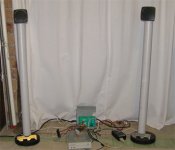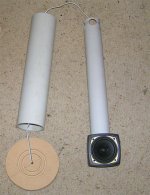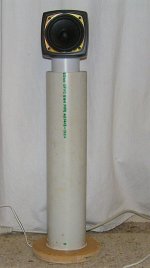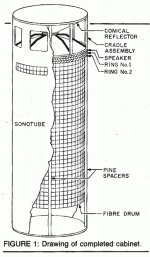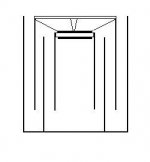Plasic TLs
I have mentioned on a few other threads my intro into TLs. After a bit of testing with 3" driver placed on top of 29" of 80mm PVC, suspended from a camera tripod, I hacked the rear satellite housings from an Altec Lansing ACS45, and glued them to 30" of 50mm PVC tubing. I am not using the original Altec drivers, as the suspension is a bit stiff.
The drivers are from a Packard Bell - Diamond Audio Technology PC multimedia set. I have no details of these, and guessed the Fr to be about 130 Hz. I suspect they may be a bit lower, thus the longer tubes. 90-20KHz
They sound great. Bass is thin, but what can one expect from a 3" driver? I estimate 10db down at 50 Hz. But what is there is smooth. No sign of one-note boominess. Midrange and transients are great. I haven't noticed undue ripple in the midrange, though still have a bit too much midrange from the open end - more damping needed.
I started with 2 cotton nylon blend socks in the 80mm tube. Now have a piece of tontine and a sock in each tube.
The system is definately better the the original plastic tuned port BRs. I am still using the amp that was mounted in one of the cases.
Bang for bucks? Plenty. Everything I had on hand, except the 50 mm PVC. Found that on the side of the road a few days ago. It had TL written all over it.
Next stage is to try tapered plugs/fine tuning the length, then a mounting foot.
Once the're finnished, they will be the rear satellites on the main system. (classic Hefner type bridge) So bass and power are not a big issue.
They would also be ideal as near field monitors. Spaced 80cms, listening on the apex,
I have mentioned on a few other threads my intro into TLs. After a bit of testing with 3" driver placed on top of 29" of 80mm PVC, suspended from a camera tripod, I hacked the rear satellite housings from an Altec Lansing ACS45, and glued them to 30" of 50mm PVC tubing. I am not using the original Altec drivers, as the suspension is a bit stiff.
The drivers are from a Packard Bell - Diamond Audio Technology PC multimedia set. I have no details of these, and guessed the Fr to be about 130 Hz. I suspect they may be a bit lower, thus the longer tubes. 90-20KHz
They sound great. Bass is thin, but what can one expect from a 3" driver? I estimate 10db down at 50 Hz. But what is there is smooth. No sign of one-note boominess. Midrange and transients are great. I haven't noticed undue ripple in the midrange, though still have a bit too much midrange from the open end - more damping needed.
I started with 2 cotton nylon blend socks in the 80mm tube. Now have a piece of tontine and a sock in each tube.
The system is definately better the the original plastic tuned port BRs. I am still using the amp that was mounted in one of the cases.
Bang for bucks? Plenty. Everything I had on hand, except the 50 mm PVC. Found that on the side of the road a few days ago. It had TL written all over it.
Next stage is to try tapered plugs/fine tuning the length, then a mounting foot.
Once the're finnished, they will be the rear satellites on the main system. (classic Hefner type bridge) So bass and power are not a big issue.
They would also be ideal as near field monitors. Spaced 80cms, listening on the apex,
Attachments
After much listening to these marvels, I decided to convert to a folded TL. Rather than using bends to make a u-turn, I went concentic. A length of 80 mm pipe would provide the same cross-sectional area as the 50mm, with the 50mm inside. Glued to a timber base.
The bits waiting to be glued:
The bits waiting to be glued:
Attachments
The annular grooves in the base locate the tubes. The smaller was cut with a hole saw. The larger was cut using a arbor in the base, mounted on a drill press, with an 5/32 drill. Poor man's mill/router!!
Before cutting, I checked the resonance. By setting up a telescoping section, I could adjust the length with music playing. What's needed here is a bit of 12 bar with good solid walking bass. Simply adjust the length to get a flat response over the bottom octave on a bass guitar.
I then checked the fr, 103 Hz. My method gave 32 - 33 inches. the finished length is 32.25. So does the formula!
The bass has come up a bit and less phase shifting around the room, most likely due to the port and driver being closer.
I haven't worried about BC yet, I'll probably build that into a surround decoder.
To me, it's not so much a question of what enclosure for a given driver, but what driver will work in a 1/4 wave TL. I'm hooked. I might even part with my Altec 411s.
Before cutting, I checked the resonance. By setting up a telescoping section, I could adjust the length with music playing. What's needed here is a bit of 12 bar with good solid walking bass. Simply adjust the length to get a flat response over the bottom octave on a bass guitar.
I then checked the fr, 103 Hz. My method gave 32 - 33 inches. the finished length is 32.25. So does the formula!
The bass has come up a bit and less phase shifting around the room, most likely due to the port and driver being closer.
I haven't worried about BC yet, I'll probably build that into a surround decoder.
To me, it's not so much a question of what enclosure for a given driver, but what driver will work in a 1/4 wave TL. I'm hooked. I might even part with my Altec 411s.
Geoff H said:After much listening to these marvels, I decided to convert to a folded TL. Rather than using bends to make a u-turn, I went concentic. A length of 80 mm pipe would provide the same cross-sectional area as the 50mm, with the 50mm inside. Glued to a timber base.
The bits waiting to be glued:
Wow, very innovative solutions to some distinct problems. I appreciate that. Congratulations.
Dave
Hi Dave, I just hit the wrong button, and nearly reported you.
I have thought about the offset. I have 2 more of those shells. I could cut a shape in the pipe, and hold the shell in a jig of somesort and run a hole saw to match the pipe. I bit like line boring. Getting a grip on the plastic without crushing it is the problem. Then I could sit down in front of a good DVD, with a file. Beats knitting!
I think I found the limit of these things this morning. Not happy with Pink Floyd at realistic levels. Too much bass energy for them. Yet on most recordings happy to show 90 dB at 2 metres on a 4 watt /ch amp
I have thought about the offset. I have 2 more of those shells. I could cut a shape in the pipe, and hold the shell in a jig of somesort and run a hole saw to match the pipe. I bit like line boring. Getting a grip on the plastic without crushing it is the problem. Then I could sit down in front of a good DVD, with a file. Beats knitting!
I think I found the limit of these things this morning. Not happy with Pink Floyd at realistic levels. Too much bass energy for them. Yet on most recordings happy to show 90 dB at 2 metres on a 4 watt /ch amp
Hi Panomaniac.
The innertube does go all the way to the base. I'm still working on zero gravity.
The 4 holes in the centre tube match the cross sectional area of the inner tube. When assembled, the ports meet the base.
The two annular grooves want to be a good fit on the tubes, and the tubes filed flat and square to get a good joint.
I had thought of a method to keep the centre pipe centered at the top,
so far the glue is doing that. I used an MEK based contact adhesive.
edit. And I should read all the post before I respond.
The innertube does go all the way to the base. I'm still working on zero gravity.
The 4 holes in the centre tube match the cross sectional area of the inner tube. When assembled, the ports meet the base.
The two annular grooves want to be a good fit on the tubes, and the tubes filed flat and square to get a good joint.
I had thought of a method to keep the centre pipe centered at the top,
so far the glue is doing that. I used an MEK based contact adhesive.
edit. And I should read all the post before I respond.
I had a go with such enclosure ...
Cutting a hole at the bottom of the inner cylinder is not a good choice as far as folded TLs are concerned if you ask me. The cross section changes should be at a minimum in order to reduce the reflected energy.
http://www.yildiz.edu.tr/~ilkorur/speaker/seas_h487.html
This is a TL I have build for Seas co-axial speakers. The 90 degrees bend enables the sound waves enter the cylinders smoothly. The carpet at the bottom of the enclosure reduces the reflected midrange. However it can be improved if a curved piece is placed in the place of that carpet. The cross-sectional area is same at all points.
If I were to design this enclosure again, I would like to see what improvement could a lightly daped rear chamber make.
/Onur
Cutting a hole at the bottom of the inner cylinder is not a good choice as far as folded TLs are concerned if you ask me. The cross section changes should be at a minimum in order to reduce the reflected energy.
http://www.yildiz.edu.tr/~ilkorur/speaker/seas_h487.html
This is a TL I have build for Seas co-axial speakers. The 90 degrees bend enables the sound waves enter the cylinders smoothly. The carpet at the bottom of the enclosure reduces the reflected midrange. However it can be improved if a curved piece is placed in the place of that carpet. The cross-sectional area is same at all points.
If I were to design this enclosure again, I would like to see what improvement could a lightly daped rear chamber make.
/Onur
Hello Onur.
Thanks for the comment. I wanted a quick-n-easy solution. The 4 1" holes have the same crossectional area as the inner tube. The gap between the 2 tubes is slightly less, IIRC about 90%. So the cross sectional area is fairly constant.
As I understand it, when the pressure wave reaches the end of the inner tube, it has now where to go, except for the 4 ports. That pressure builds up, and travells up the outer tube. If some of the high frequency energy is reflected back up the tube, it's absorbed by the damping material. There is a handful just below the driver, and some more 1/2 way down the outer tube.
I did have a convex piece in the base of the first version, it was the hole cut from the shell (the black bit), and was primarily put there to centre the tube around the pedistal. I might be able to get it in there again. I will have to extract the damping first.
Thanks for the comment. I wanted a quick-n-easy solution. The 4 1" holes have the same crossectional area as the inner tube. The gap between the 2 tubes is slightly less, IIRC about 90%. So the cross sectional area is fairly constant.
As I understand it, when the pressure wave reaches the end of the inner tube, it has now where to go, except for the 4 ports. That pressure builds up, and travells up the outer tube. If some of the high frequency energy is reflected back up the tube, it's absorbed by the damping material. There is a handful just below the driver, and some more 1/2 way down the outer tube.
I did have a convex piece in the base of the first version, it was the hole cut from the shell (the black bit), and was primarily put there to centre the tube around the pedistal. I might be able to get it in there again. I will have to extract the damping first.
I have just had a look at Onur's TL's.
If some one had asked me a month ago about using plastic pipes for speakers I would have said forget it. But tubes don't vibrate and radiate like flat pannels. I am wondering if the steel tube radiates at all. I want to have a shot at a sub. I think I can get a LPG cylinder about 18" in dia an 5ft high.
The Sonnotube Dave spoke about wouldn't need the cone deflector for sub base use, and it could be inverted and placed on legs. I have also thought about placing the driver half way down the inner tube. It's easy, but I'll draw it up rather than describe it. In fact its too easy. The cone still radiates to the atmosphere, yet it's not at the end of the tube.
If some one had asked me a month ago about using plastic pipes for speakers I would have said forget it. But tubes don't vibrate and radiate like flat pannels. I am wondering if the steel tube radiates at all. I want to have a shot at a sub. I think I can get a LPG cylinder about 18" in dia an 5ft high.
The Sonnotube Dave spoke about wouldn't need the cone deflector for sub base use, and it could be inverted and placed on legs. I have also thought about placing the driver half way down the inner tube. It's easy, but I'll draw it up rather than describe it. In fact its too easy. The cone still radiates to the atmosphere, yet it's not at the end of the tube.
Let No Damping material to cover the cross-section!
Maybe it will be a big modification but I suggest you to remove all the absorbing material inside the line and replace it with thin, furry carpet which will cover the inner walls of the cylinder. If you force the thin carpet in, it will make the walls more rigid and at the same time it will work as an absorber. The main reason of this modification is to leave the center of the line open. If you close it by placing absorbing material you can never imagine to what extend you are reducing the low frequency radiation. The aim of the game is not to generate heat from the unwanted waves but to use them to generate more low end response.
/Onur
If some of the high frequency energy is reflected back up the tube, it's absorbed by the damping material. There is a handful just below the driver, and some more 1/2 way down the outer tube.
Maybe it will be a big modification but I suggest you to remove all the absorbing material inside the line and replace it with thin, furry carpet which will cover the inner walls of the cylinder. If you force the thin carpet in, it will make the walls more rigid and at the same time it will work as an absorber. The main reason of this modification is to leave the center of the line open. If you close it by placing absorbing material you can never imagine to what extend you are reducing the low frequency radiation. The aim of the game is not to generate heat from the unwanted waves but to use them to generate more low end response.
/Onur
Hi Geoff,
Just curious: have you checked out www.t-linespeakers.org, or more importantly, www.quarter-wave.com? They will be helpful for design theory and modelling, if you haven't already used the tools there.
Dave
Just curious: have you checked out www.t-linespeakers.org, or more importantly, www.quarter-wave.com? They will be helpful for design theory and modelling, if you haven't already used the tools there.
Dave
Hi kneadle, thanks, I have checked those sites, and a number of others.
What I have ended up with is a project to entertain a teenager on a wet weekend, and collectively, some ideas to improve on it.
The earlier drawing was in response to Planet 10s comments and link to a sub, and placing the driver down the line. When I posted that I hadn't realised how many other posts had gone up.
Onur, I think I have the damping or stuffing close to optimum. These things easily match or maybe better the bass from the 8" driver of Altec Atlantics, from a 3" driver. The transient testing backs that up, just a click, not a bonk.
What I have ended up with is a project to entertain a teenager on a wet weekend, and collectively, some ideas to improve on it.
The earlier drawing was in response to Planet 10s comments and link to a sub, and placing the driver down the line. When I posted that I hadn't realised how many other posts had gone up.
Onur, I think I have the damping or stuffing close to optimum. These things easily match or maybe better the bass from the 8" driver of Altec Atlantics, from a 3" driver. The transient testing backs that up, just a click, not a bonk.
- Status
- This old topic is closed. If you want to reopen this topic, contact a moderator using the "Report Post" button.
- Home
- Loudspeakers
- Full Range
- Plastic TLs
